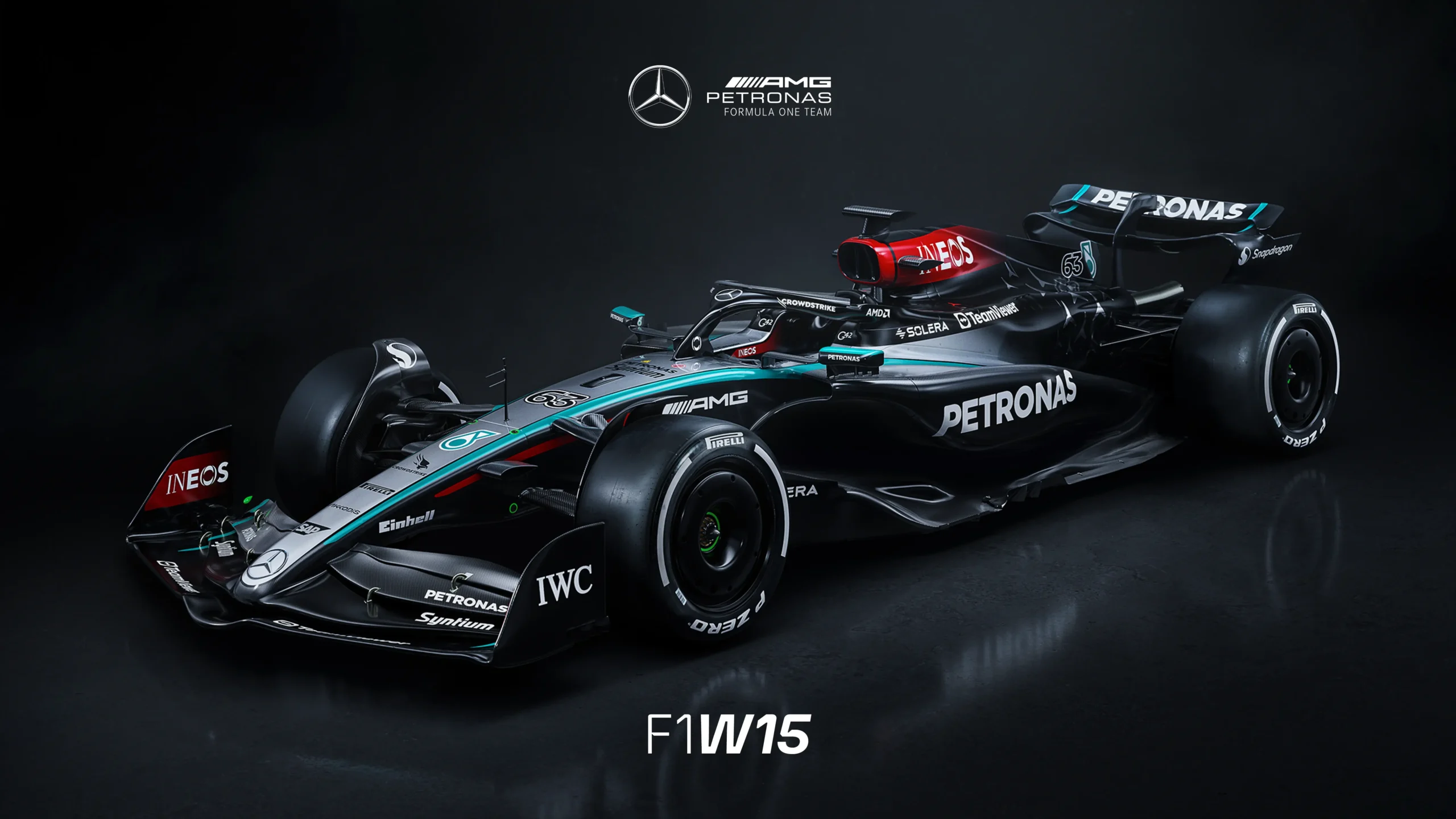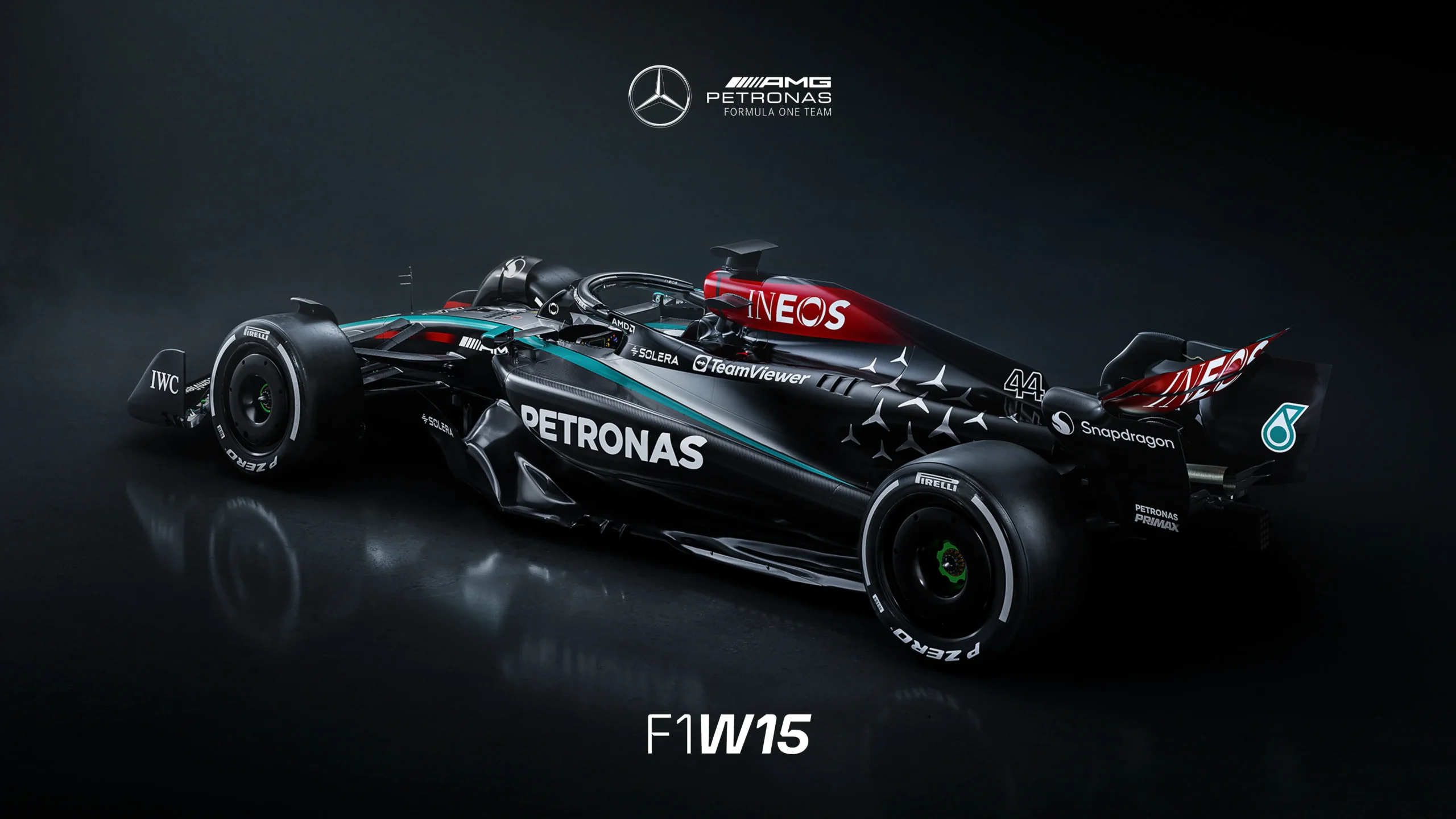
What's New
The biggest innovations in the Mercedes-AMG F1 W15 E Performance focus on aerodynamics and potential powertrain tweaks, with the goal of improved performance and closer racing.
Aerodynamic Revolution:
- Ground Effect’s Return: The most significant change is the return of ground effects. The W15 utilizes an underfloor design that creates a low-pressure zone beneath the car, generating significant downforce for faster cornering speeds. However, it also demands precise setup and driving skills.
- Simplified Wings: To reduce dirty air and improve overtaking opportunities, the W15 has less complex front and rear wings compared to the W14. This might slightly reduce downforce, but aims to create closer racing and exciting battles on the track.
Powertrain Considerations:
- Carries Over Power Unit: The W15 retains the reliable 1.6-liter V6 turbo hybrid engine with a maximum power output of around 1000 bhp (746 kW). However, the focus might shift towards increased efficiency to complement the aerodynamic changes.
- Potential MGU-K Boost: Regulations allow for an increase in the MGU-K’s (Motor Generator Unit – Kinetic) power output. This could provide a significant boost in electrical power and acceleration if implemented by Mercedes.
Additional Areas of Improvement:
- Weight Reduction: Stricter weight regulations in 2024 push teams to find innovative ways to make the W15 lighter, potentially leading to faster lap times.
- Suspension Refinements: Mercedes might have made adjustments to the suspension for better handling characteristics on various track types.
- Advanced Data Analytics: Undoubtedly, Mercedes continues to leverage sophisticated data analysis to optimize car performance and make strategic decisions during races.
Stay Updated on the W15:
- Mercedes AMG F1 Website: Keep an eye on their official website (https://www.mercedesamgf1.com/) for press releases, car launch details, and technical insights.
-
Technical Specification
-
Engine Specification
Monocoque
Moulded carbon fibre and honeycomb composite structure
Bodywork
Carbon fibre composite including engine cover, sidepods, floor, nose, front wing, and rear wing
Cockpit
Removable driver’s seat made of anatomically formed carbon composite, six-point driver safety harness, HANS system
Safety Structures
Cockpit survival cell incorporating impact-resistant construction and penetration panels, front impact structure, prescribed side impact structures, integrated rear impact structure, front and rear roll structures, titanium driver protection structure (halo)
Front Suspension
Carbon fibre wishbone and push rod-activated springs and dampers
Rear Suspension
Carbon fibre wishbone and push rod-activated inboard springs & dampers
Wheels
BBS forged magnesium
Tyres
Pirelli
Brake System
Carbone Industries Carbon / Carbon discs and pads with rear brake-by-wire
Brake System
Brembo monobloc calipers in nickel-plated aluminium alloy machined from solid block (front and rear)
Steering
Power-assisted rack and pinion
Steering Wheel
Carbon fibre construction
Electronics
FIA standard ECU and FIA homologated electronic and electrical system
Instrumentation
McLaren Electronic Systems (MES)
Fuel System
ATL Kevlar-reinforced rubber bladder
Lubricants & Fluids
PETRONAS Tutela
Gearbox
Eight speed forward, one reverse unit with carbon fibre main case
Gear Selection
Sequential, semi-automatic, hydraulic activation
Clutch
Carbon plate
Type: Mercedes-AMG F1 M15 E PERFORMANCE
Minimum Weight: 150 kg
Power Unit Perimeter:
- Internal Combustion Engine (ICE)
- Motor Generator Unit – Kinetic (MGU-K)
- Motor Generator Unit – Heat (MGU-H)
- Turbocharger (TC)
- Energy Store (ES)
- Control Electronics (CE)
Power Unit Allocation:
- Four ICE, TC, MGU-K & MGU-H per driver per season
- Two ES & CE per driver per season
Internal Combustion Engine (ICE)
- Capacity: 1.6 litres
- Cylinders: Six
- Bank Angle: 90
- No of Valves: 24
- Max rpm ICE: 15,000 rpm
- Max Fuel Flow Rate: 100 kg/hour (above 10,500 rpm)
- Fuel Injection: High-pressure direct injection (max 500 bar, one injector/cylinder)
- Pressure Charging: Single-stage compressor and exhaust turbine on a common shaft
- Max rpm Exhaust Turbine: 125,000 rpm
Energy Recovery System (ERS)
- Architecture: Integrated Hybrid energy recovery via electrical Motor Generator Units
- Energy Store: Lithium-Ion battery solution of minimum 20 kg regulation weight
- Max useable energy storage on track: 4 MJ
- Max rpm MGU-K: 50,000 rpm
- Max power MGU-K: 120 kW (161 hp)
- Max energy recovery/lap MGU-K: 2 MJ
- Max energy deployment/lap MGU-K: 4 MJ (33.3 s at full power)
- Max rpm MGU-H: 125,000 rpm
- Max power MGU-H: Unlimited
- Max energy recovery/lap MGU-H: Unlimited
- Max energy deployment/lap MGU-H: Unlimited
Fuel & Lubricants
- Fuel: PETRONAS Primax
- Lubricants: PETRONAS Syntium

